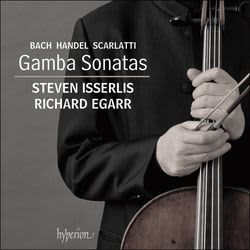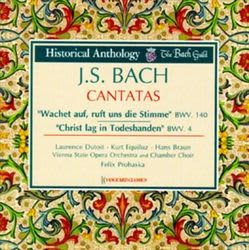Περιγραφή
Καλλιτέχνες
|
1685—what a year! The storks must have been working overtime, earning bonuses for high-quality deliveries. There have, it’s true, been occasional years which have produced two great composers (notably 1810, birth-year of both Schumann and Chopin), but 1685 is unique in having seen the arrival of three composers of genius. Bach, Handel and Scarlatti would turn out to be very different characters, personally and creatively; but all three of them would produce imperishable music that would change the world. How pleased the angels (and storks) must have felt as they looked down at the three red-faced, squalling babies, and foresaw their futures! It is fitting that Bach gets the lion’s share of this album, since of the three composers his contribution to solo and chamber music for strings is by far the most substantial and significant. The most famous examples are of course his six sonatas and partitas for solo violin and six suites for solo cello; but his sonatas for keyboard with violin and with viola da gamba are also masterpieces. The gamba sonatas do not form a unified set, as do (for instance) the cello suites; but with their generous range of moods and forms, all expressed in Bach’s uniquely elevated musical language, the three sonatas make a deeply satisfying triptych. We do not know exactly when the sonatas were composed, but modern research suggests that all were written in Leipzig (where Bach lived from 1723 until his death) during the composer’s later years. This theory is supported by the only surviving manuscript in Bach’s own hand, which is of the first sonata; tests have shown this copy to date from around 1740. Perhaps the sonatas were written for the gamba virtuoso Carl Friedrich Abel, who spent the years 1737 to 1743 in Leipzig. Some writers have claimed that all three sonatas may have originated as works for other instruments; there is no definite evidence for this, however—except in the case of the Sonata in G major, BWV1027, which also exists in an earlier version for two flutes and continuo, BWV1039. It might seem strange that a sonata originally conceived for two instruments and keyboard should work equally well for one instrument and keyboard; but actually it makes perfect sense. All three gamba sonatas are trio sonatas, written for three equal voices—one being the gamba, the other two the treble and bass of the keyboard. (The works by Handel and Scarlatti on this album, on the other hand, are sonatas for solo instrument with continuo—hence the added cello, to reinforce the harpsichord’s bass line.) Playing these Bach sonatas on the cello—the gamba’s rather more robust younger brother, or at least cousin—perhaps throws up a few more questions of balance than arise between the gentle gamba and its old friend the harpsichord; but these are by no means insuperable. And it is lovely for us cellists, used to making our presence felt with some difficulty over the rich sound of a modern piano, to be able to play as lightly as possible without ever courting inaudibility. Both versions of the first sonata are set in the key of G major. Bach’s contemporary Johann Mattheson, in his treatise on the natures of different tonalities, quotes a description of G major as ‘a true guardian of moderation’. All four movements of this work certainly bear out this characterization; even the faster ones are marked Allegro ma non tanto and Allegro moderato—no room for extremism here. From the lilting melody with which the opening Adagio begins, through to the triumphant flourish that concludes the sonata, we are in a pastoral world where all is well. Only the ending of the Andante unexpectedly breaks out of this idyllic world; here the gamba’s descending cry, reminiscent of the tragic aria with gamba solo ‘Es is vollbracht’ (‘It is finished’), from the St John Passion, perhaps conveys something of the suffering that lies behind deep joy. Domenico Scarlatti was a very different character in every way from Bach; the contrast between the latter’s German Lutheran sensibilities and the former’s resplendent eccentricity is striking, both biographically and musically. Whereas Bach never left his native Germany, Scarlatti was an international traveller. Born in Naples, he spent much of his life in Portugal and Spain, the vibrant colours and sounds of all these places permeating his art. He is best known for a collection of well over 500 keyboard sonatas (or ‘essercizi’), most of them consisting of a single movement; the vast majority were published well after Scarlatti’s death. A handful of these sonatas have figured basses written underneath the bass part; in 1947 the harpsichordist Lionel Salter wrote an article convincingly arguing that they were actually intended as sonatas for violin and basso continuo. Of these violin sonatas, the Sonata in D minor, Kk90, is probably the finest. A rather later commentator than Mattheson, the lead guitarist of the (spoof) rock group Spinal Tap, Nigel Tufnel, describes D minor as a key that ‘makes people weep instantly’; perhaps Scarlatti was a Spinal Tap fan, because this sonata certainly seems to follow that precept. The romantic opening aria—a heroine’s lamentation?—takes us immediately into an operatic world utterly different from Bach’s. This is followed by a fizzy Allegro, overflowing with irrepressible energy and humour. The last two sections—both dances, one a confident 12/8, the other a languorous 3/8 (strangely, it is the latter, not the former, which is marked Allegro in the manuscript)—seem to us three performers to make most sense as a ‘da capo’ pair. There is no evidence to support this decision (though hardly any to counter it, either; Scarlatti remains a difficult figure for musicologists)—but it just seems to work. Bach’s Sonata in G minor, BWV1029, the only one of the gamba sonatas containing just three movements, in some ways resembles a concerto in the Italian style; this has led many writers to suggest that it was originally a concerto grosso (a seventh Brandenburg Concerto, in fact), and even to reconstruct it as such. However, when one remembers that Bach frequently composed in concerto form with no orchestra involved (think of the Italian Concerto) and considers how perfectly the sonata works as a duo, this theory becomes less attractive. The opening movement, marked Vivace (often a slower tempo than Allegro in Baroque times), with its jagged, bustling subjects and episodes, may remind us of the Brandenburg concertos; but the slow movement is something else altogether, an extraordinary creation in which the two instruments seem to float apart through a rarefied world, barely acknowledging each other’s presence until well into the movement. The final Allegro, too, confounds expectations: the fugue-like opening theme, shared equally by all three voices, is countered by a tender, singing second subject—a clear foreshadowing of the contrasting subjects of Classical and Romantic sonata forms. The work as a whole shows us Bach’s predilection for clothing transformative ideas in ostensibly traditional forms. To think that in his own time, he was considered old-fashioned! Like Scarlatti, Handel was an inveterate traveller (compared to Bach, at least). Before settling in England, where he was to spend most of his life, Handel had spent time in Italy. There he met Scarlatti, and the two men became friends. A story was told about Handel attending a fancy dress party in Venice in disguise; as was his wont, he sat down at the harpsichord, and started playing. Scarlatti wandered over to listen, and was transfixed. ‘Either that is the famous Saxon’, he exclaimed, ‘or the Devil.’ It was said that in later life Scarlatti would cross himself reverently every time Handel’s name was mentioned. Like Scarlatti’s, some of Handel’s violin sonatas were for a long time thought to be intended for other instruments, several of them initially appearing as sonatas for oboe or flute. Furthermore, they were often grouped together with spurious sonatas misattributed to Handel; it is only in recent years that the confusion has been properly resolved, and this comparatively neglected side of his output has started to receive its due. The present Sonata in G minor, HWV364b, composed around 1724, was originally published as an oboe sonata. In fact, it is very much a violin sonata; but there is an authentic alternative version as well. The first page of the manuscript contains the opening bars of the violin part rewritten an octave lower in a different clef, with the words ‘per la viola da gamba’ appended in Handel’s hand—making it Handel’s only gamba sonata. Opening with a singing Andante larghetto, again far more operatic than anything in Bach’s sonatas, and concluding with a rumbustious gigue, the work is a wonderful example of a great composer writing in, and transcending, a popular style of the day. We have left Bach’s second gamba sonata, the Sonata in D major, BWV1028, until last on this album; this might seem curious, perhaps—until you hear it. It is a show-stopper! The melting first movement leads straight into a high-spirited dancing Allegro (the earliest sources give no tempo indication, but the default setting for such movements would be Allegro), which is in turn followed by a melancholic, siciliano-like Andante in B minor. All poignancy is swept aside, however, by an Allegro of such joyous virtuosity—both instruments attempting to outdo each other in increasingly wild episodes—that we felt that this sonata had to conclude the album. Except that in the end it didn’t. A couple of days before we made this recording, Richard and I had a discussion about what to play as an encore at a recital we were giving. I hesitatingly suggested one of my all-time favourite works, Bach’s Chorale Prelude (originally for organ, from the Orgelbüchlein) Ich ruf’ zu dir, Herr Jesu Christ; but then withdrew the idea, daring to say that perhaps it wouldn’t work on the harpsichord. Richard begged (in his characteristically colourful language) to differ; but the argument remained unresolved, because I forgot to take the music to the recital (ahem!). I did, however, take it to the recording session; and, having played it through just for interest’s sake, I was immediately convinced that it does work on the harpsichord—at least in Richard’s hands. So here it is: Bach at his most gloriously sublime. The God of Music indeed. |









